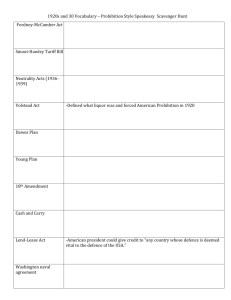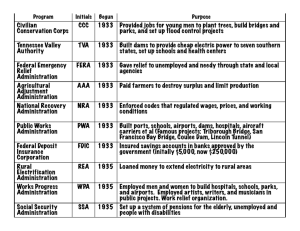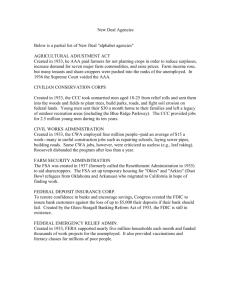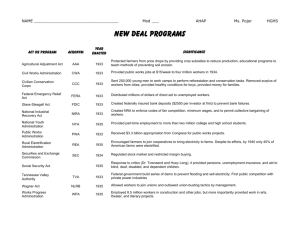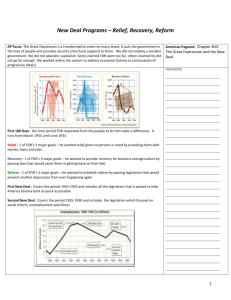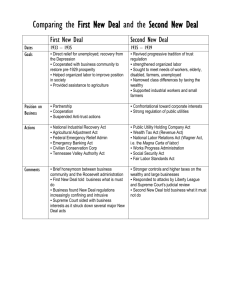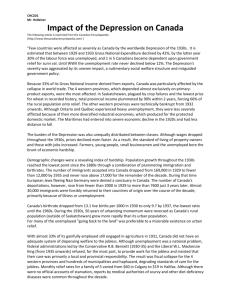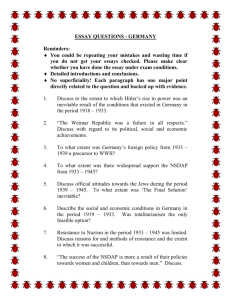New Deal Programs - Polk County Public Schools
advertisement
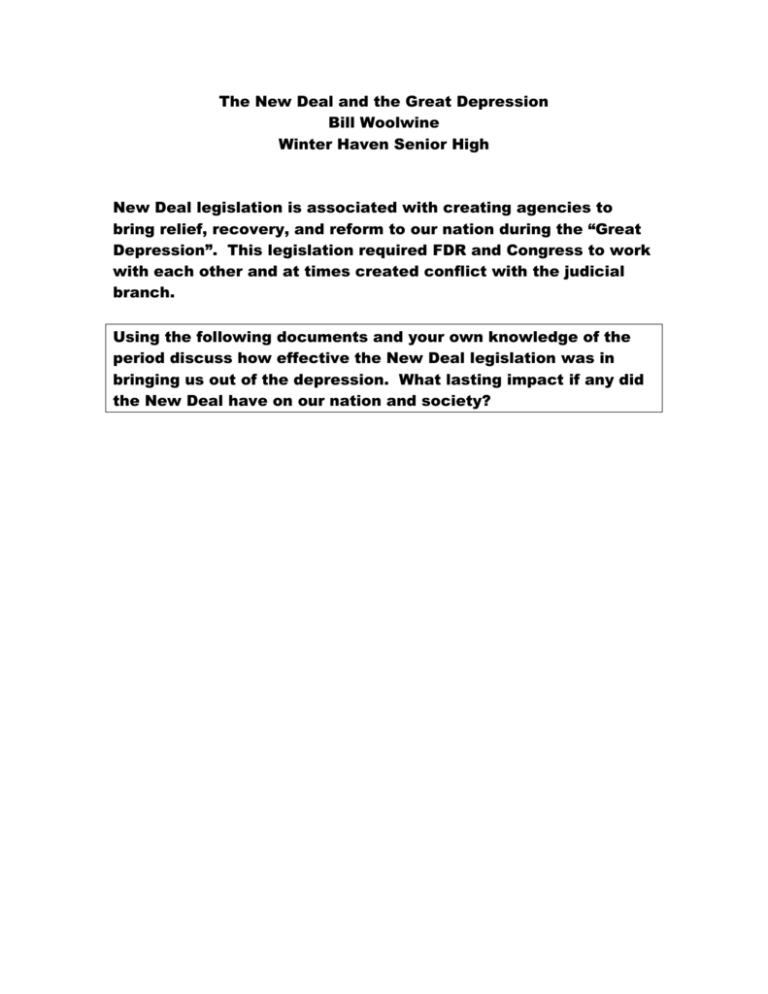
The New Deal and the Great Depression Bill Woolwine Winter Haven Senior High New Deal legislation is associated with creating agencies to bring relief, recovery, and reform to our nation during the “Great Depression”. This legislation required FDR and Congress to work with each other and at times created conflict with the judicial branch. Using the following documents and your own knowledge of the period discuss how effective the New Deal legislation was in bringing us out of the depression. What lasting impact if any did the New Deal have on our nation and society? New Deal Programs Act or Program Acronym Year Significance Enacted Agricultural Adjustment Act AAA 1933 Protected farmers from price drops by providing crop subsidies to reduce production, educational programs to teach methods of preventing soil erosion. Civil Works Administration CWA 1933 Provided public works jobs at $15/week to four million workers in 1934. Civilian Conservation Corps CCC 1933 Sent 250,000 young men to work camps to perform reforestation and conservation tasks. Removed surplus of workers from cities, provided healthy conditions for boys, provided money for families. Federal Emergency Relief Act FERA 1933 Distributed millions of dollars of direct aid to unemployed workers. Glass-Steagall Act FDIC 1933 Created federally insured bank deposits ($2500 per investor at first) to prevent bank failures. National Industrial NIRA Recovery Act 1933 Created NRA to enforce codes of fair competition, minimum wages, and to permit collective bargaining of workers. National Youth Administration NYA 1935 Provided part-time employment to more than two million college and high school students. Public Works Administration PWA 1933 Received $3.3 billion appropriation from Congress for public works projects. Rural Electrification Administration REA 1935 Encouraged farmers to join cooperatives to bring electricity to farms. Despite its efforts, by 1940 only 40% of American farms were electrified. Securities and Exchange Commission SEC 1934 Regulated stock market and restricted margin buying. 1935 Response to critics (Dr. Townsend and Huey Long), it provided pensions, unemployment insurance, and aid to blind, deaf, disabled, and dependent children. Social Security Act Tennessee Valley Authority TVA 1933 Federal government built a series of dams to prevent flooding and sell electricity. First public competition with private power industries Wagner Act NLRB 1935 Allowed workers to join unions and outlawed union-busting tactics by management. Works Progress Administration WPA 1935 Employed 8.5 million workers in construction and other jobs, but more importantly provided work in arts, theater, and literary projects. Feldmeth, Greg D. "U.S. History Resources" http://home.earthlink.net/~gfeldmeth/USHistory.html (31 March 1998) The United States Supreme Court Building: Washington D. C. 1. What role did the Supreme Court play during the Great Depression? 2. How did FDR get along with the Court? 3. What constitutional question arose during the depression and what was the conclusion? Table 1: Statistics[79] 1929 1931 1933 1937 1938 1940 Real Gross National Product (GNP) (1) 101.4 84.3 68.3 103.9 96.7 113.0 Consumer Price Index (2) 122.5 108.7 92.4 102.7 99.4 100.2 Index of Industrial Production (2) 109 75 69 112 89 126 Money Supply M2 ($ billions) 46.6 42.7 32.2 45.7 49.3 55.2 Exports ($ billions) 5.24 2.42 1.67 3.35 3.18 4.02 Unemployment (% of civilian work force) 3.1 16.1 25.2 13.8 16.5 13.9 (1) in 1929 dollars (2) 1935-39 = 100 1. What does this chart say about the economy between 1929 and 1940? 2. What happened to exports during this period and why? 3. What happened to the unemployment rate during this period? Table 2: Unemployment (% labor force) Year 1933 1934 1935 1936 1937 1938 1939 1940 1941 1942 1943 1944 1945 Lebergott 24.9 21.7 1941? 16.9 14.3 19.0 17.2 14.6 9.9 4.7 1.9 1.2 1.9 Darby 20.6 16.0 14.2 9.9 9.1 12.5 11.3 9.5 8.0 4.7 1.9 1.2 1.9 Darby counts WPA workers as employed; Lebergott as unemployed source: Historical Statistics [80] US(1976) series D-86; Smiley 1983 1. What does the chart about unemployment? 2. Why did the unemployment rise again after 1938 3. Why did unemployment go down after [edit] Relief statistics Families on Relief 1936-41 Relief Cases 1936-1941 monthly average in 1,000 1936 1937 1938 Workers employed: WPA CCC and NYA Other federal work projects Public assistance cases: Social security programs General relief 1939 1940 1941 1,995 2,227 1,932 2,911 1,971 1,638 712 801 643 793 877 919 554 663 452 488 468 681 602 1,306 1,852 2,132 2,308 2,517 2,946 1,484 1,611 1,647 1,570 1,206 5,886 5,660 5,474 6,751 5,860 5,167 Total families helped Unemployed workers (Bur Lab Stat) 9,030 7,700 10,390 9,480 8,120 5,560 coverage (cases/unemployed) 65% 74% 53% 1. What does the chart show about the role of the New Deal? 2. What successes do you see? 3. What is significant about 1941? 71% 72% 93% 1. What is the cartoonist trying to convey? 2. What is the view of the American people toward FDR and the New Deal? 3. What groups would tend to make up the detractors? Bread line standing in front of a billboard showing prosperity 1. How does this picture show differences between prosperity and poverty? 2. How does this photo show differences between the races during the depression? 3. Is this an accurate depiction?
